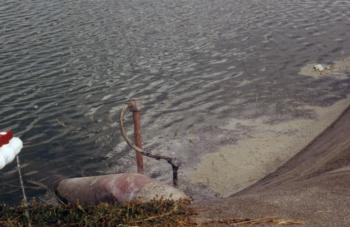University of California
Maintenance of Microirrigation Systems
Prediction of biological clogging hazard

Water in an irrigation reservoir with a high organic contamination level Photo: L. Schwankl
For the sake of simplicity, the following guidelines may prove useful in predicting the need to treat for biological clogging.
- When using surface water, you should start with the assumption that you will need to take steps to mitigate the biological clogging of emitters.
- Visual evidence of organic contamination, such as a greenish tint to the water or algae floating in the water, are indicators that water treatment to prevent biological clogging problems will be necessary.
- Monitor the filters and filter flush water for any evidence of a buildup of organic contaminants. Pay special attention to sand media filters to keep organic matter from building up there. If the biocide injection point is downstream of the sand filters, you can still apply periodic biocide treatments of the filters via the access port on each of the media tanks.
- Monitor for an organic contaminant buildup when flushing the system. Catching the lateral line flush discharge with cheesecloth or a nylon mesh cloth like that used for a paint strainer is an excellent way to determine what contaminants are making their way through the filters or are growing in the micrroirrigation system.
- Even as simple a diagnostic step as running your finger around the inside of drip tubing at the head or tail end of lateral lines can help you diagnose a buildup of organic contaminants. If the inside of the lines feel slimy to the touch, a biocide treatment is likely warranted.
